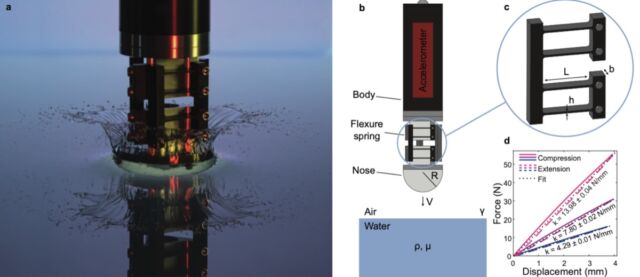We’ve all had the misfortune of botching a dive into the pool and ending up in a painful belly-flop—or perhaps we’ve done it deliberately to show off and instantly regretted that decision. Hitting the water in that body position can feel like hitting concrete and lead to bruising or (if one is falling from a greater height) internal injuries. While the basic physics is well-understood, scientists are always looking for greater insight into the phenomenon in hopes of finding novel ways to ameliorate the impact.
Scientists at Brown University have found that, surprisingly, adding a bit of extra spring to a body hitting the water can actually increase the impact force instead of decrease it under certain conditions, according to a new paper published in the Journal of Fluid Mechanics. The implications go beyond protecting divers; a better understanding of the hydrodynamics will improve designs of naval ships, seaplanes, or projectiles, as well as underwater autonomous vehicles.
From a physics standpoint, we’re talking about an elastic body hitting the surface of water. The stress of moving from the medium of air to the much denser medium of water exerts a huge force as that body displaces it. The cohesive forces between water molecules are stronger at the surface, making it harder to break through. (It’s why diving competitions often use aerators to create bubbles in the water, breaking the surface tension to protect the divers.) A large volume of fluid must be accelerated (displaced) in a short timeframe to match the speed of the impinging body. The larger the surface area of the object hitting the water, the more resistance there will be—and with belly-flops there will be a much larger surface area than with a simple swan dive, resulting in that signature slam.
Scientists have been studying this phenomenon for a very long time, including recent work on diving birds like gannets and kingfishers. Despite the stress on their bodies, gannets and kingfishers manage the feat again and again without injury, especially concussions, thanks in part to their tapered cone-shaped beaks, enabling them to enter the water without creating a compression wave beneath the surface. Gannets also fold their wings back as they dive for a streamlined shape.
This latest study investigates the impact of more blunt bodies hitting the water surface, in which the highest impact occurs during the so-called “slamming” phase. “Most of the work that’s been done in this space looks at rigid bodies slamming into the water, whose overall shape doesn’t really change or move in response to the impact,” said co-author Daniel Harris of Brown University. “The questions that we start to get at are: ‘What if the object that’s impacting is flexible so that once it feels the force it can either change shape or deform? How does that change the physics and then, more importantly, the forces that are felt on these structures?”

For their experiments, Harris et al. built a slender rigid impactor with a blunt nose coupled together by elastic spring elements laser-cut from plastic. The springs should act like a car’s suspension, softening the impact by distributing the load over a longer period. The body housed an onboard accelerometer to measure impact deceleration as well as a ferromagnetic ball so that the impactor could be dropped from varying heights via an electromagnet. The impacts with the water were illuminated with diffuse white backlight and filmed at high speeds to capture the air-water interface action.
The results surprised the scientists, because adding the flexible springs to the impactor did not always soften the impact compared to a fully rigid impactor. Sometimes, it actually increased the maximum force on the body. Subsequent experiments revealed that in those cases, the vibrations created as the impactor hit the water sometimes also caused the springs to vibrate (harmonic oscillation), thereby increasing (rather than diminishing) the force of impact. So, the springs have to be soft enough to effectively absorb the impact without vibrating too much.
“The structure is vibrating back and forth due to the violent impact, so we were getting readings from both the impact of hitting the fluid and an oscillation because the structure is shaking itself,” Harris said. “If you don’t time those right, you can basically make the situation worse.”
Journal of Fluid Mechanics, 2023. DOI: 10.1017/jfm.2023.820 (About DOIs).
Listing image by John Antolik and Daniel Harris
https://arstechnica.com/?p=1981301

